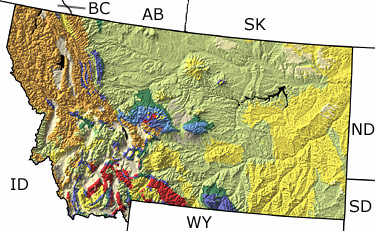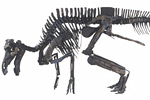Montana, US
|
|
|||||||||||||||||||||||||||||||||||||||||||||||||||||||||||||
Paleontology and geology
The Precambrian: A thick sequence of Late Precambrian sedimentary rocks indicates that the western part of Montana was covered by a warm, shallow sea. These rocks contain the oldest evidence for life in Montana, including stromatolites and trace fossils left by animals crawling along the sea floor.
The Paleozoic: Shallow marine waters continued to cover most of Montana through the early part of the Paleozoic (Cambrian), supporting a great diversity of algae, invertebrates, and some of the earliest vertebrates. Following the retreat of this sea, high rates of erosion removed most of the Silurian and Early Devonian rocks from the state. The seas returned in the Late Devonian, inundating nearly all of Montana. Crinoids, sponges, brachiopods, molluscs, conodonts, and fish thrived in the warm waters. Marine conditions persisted into the Carboniferous, and the seas were home to a remarkable diversity of cartilaginous fishes. During the Late Carboniferous (Pennsylvanian), regional uplift created highlands in the north-northwestern part of the state, and the shallow seas again retreated. Erosion of these uplifted areas continued into the Permian. The end of the Paleozoic is represented only by a thin blanket of marine sediments in the southeast that were deposited during a brief incursion of a shallow sea.
The Mesozoic: A hot, arid landscape stretched across Montana through most of the Triassic. The only fossils present are marine, indicating two brief incursions of the sea. During the Jurassic, warm, tropical seas returned to Montana, gradually retreating as eroding highlands in the west shed sediment to the east and northwest. Montana's oldest dinosaurs roamed among the vegetation of ferns, ginkgos, cycads, and conifers. Mountain building and episodes of violent volcanism mark the Cretaceous in western Montana. Terrestrial ecosystems supported a wide diversity of plants and animals, including numerous dinosaurs.
The Cenozoic: The sea retreated from Montana for the final time during the Tertiary. A major episode of tectonic activity folded and faulted the crust, creating several mountain ranges and elevating the state by thousands of meters. Dry climatic conditions alternated with wet, tropical conditions throughout this period. Large titanotheres, dogs, and other mammals roamed the landscape. The climate became increasingly wetter and cooler through the Quaternary. Glaciers expanded in the mountains of northwest Montana and the Yellowstone region, carving out mountain peaks and flattening the northern third of the state. Mammoths, dire wolves, and musk ox roamed the regions that were ice-free.
Links to more on Montana paleontology
Careers | Organizations | Education and Exhibits
CareersOrganizationsDegree and Certificate Programs (showing 1 of 1 listings)
Montana State University- Earth Sciences: Train to be a paleontologist in the MSU Undergraduate and Graduate Paleontology Programs. The Earth Sciences Department at MSU caters to both paleobiology and taphonomy interests.
Career Paths (showing 1 of 1 listings)
Paleoprofile of Kristi Curry Rogers: Biographical sketch of paleontologist Kristi Curry Rogers. Learn about her work in dinosaur paleontology in Montana and Madagascar.
Education and ExhibitsMuseums (showing 2 of 2 listings)
Museum of the Rockies: Home page for Museum of the Rockies, with links to the collections catalog, research and course information, and recent press releases.
Two Medicine Dinosaur Center: The Two Medicine Dinosaur Center is located in the Bynum-Choteau area of Montana, along the Rocky Mountain front. This area is noted worldwide for its spectacular paleontological discoveries, geological exposures, wildlife habitat, and Native American historical and archaeological sites. The Dinosaur Center is situated in this impressive area to provide hands-on programs for the general public and an interactive museum to showcase our findings. Professional researchers and instructors provide informative and entertaining experiences for all ages and interests, and programs are conducted at active research sites allowing interested persons the opportunity to experience real dinosaur paleontology.
Virtual Exhibits (showing 3 of 3 listings)
Fossil eggshell: Fragments from the past: This site explores the latest research on fossil eggshell and what an eggshell can tell us about the egg-layer — its anatomy, behavior, growth rate, identity, and more.
Paleo Video: A modern day dinosaur extinction: This video features Mark Goodwin and Jack Horner's research on pachycephalosaurs. They argue that there were fewer pachycephalosaur species in the Hell Creek Formation than we thought - two species, Dracorex hogwartsia and Stygimoloch spinifer, are actually juveniles and teenagers of the species Pachycephalosaurus wyomingensis.
Museum of the Rockies Dinosaur Paleontology Videos: This page contains links to several short films produced at the Museum of the Rockies in Bozeman, Montana (home to dinosaur paleontologist Jack Horner).
Physical Exhibits (showing 1 of 1 listings)
Makoshika Dinosaur Museum: The Makoshika Dinosaur Museum is now on the Montana Dinosaur Trail in Glendive, MT. This free admission museum will display many of the fossils of the hell creek formation in a cretaceous setting. Visit us today.

